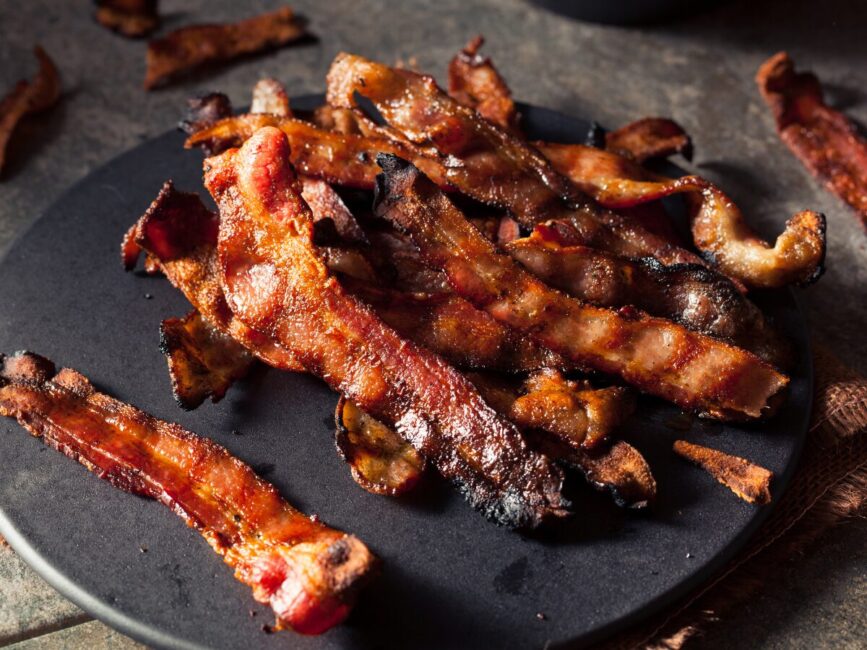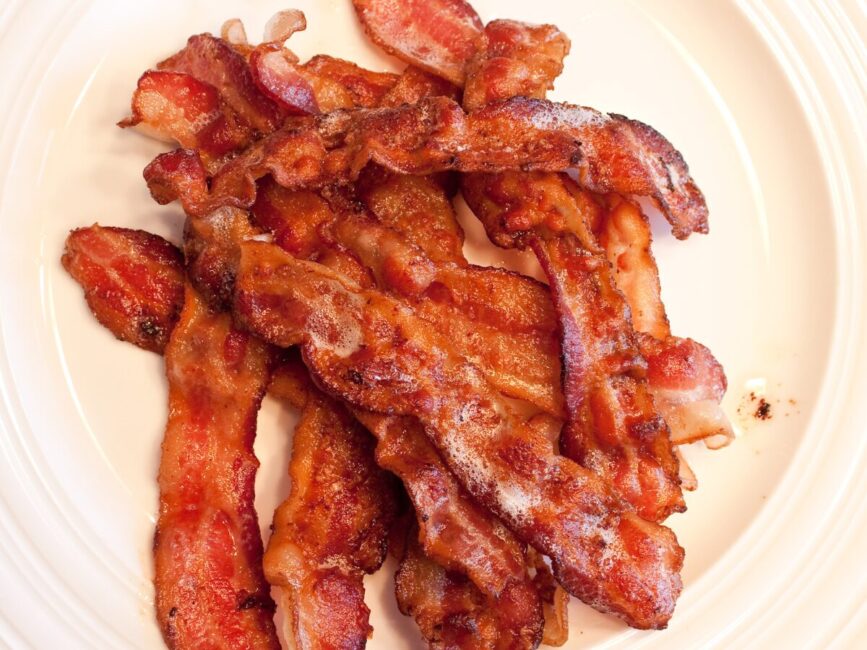I don’t know about you, but I never go through a whole package of bacon in one sitting, especially now that my boys are out of the house. That means there’s always some leftover in the package, and I often place it back in the fridge to use for later. But by the time later comes, I can’t remember if it’s still good or not! I can’t be alone in this, right?
I believe bacon makes everything better, whether on a classic southern BLT or on a salad, so I hate wasting it. That’s why I’ve decided to dive into the research and write this guide on the shelf life and proper storage of bacon. Let us never waste another strip of bacon again!
How Long Can You Keep That Bacon?
You might be surprised to find that bacon is pretty resilient when stored correctly. An unopened bacon package should last about 2 weeks in your fridge, while an opened package of uncooked bacon will last about a week. Frozen bacon will last up to 4 months in the freezer, and leftover cooked bacon (if you didn’t finish it, which, if that’s the case… how do you have the willpower?!) will stay good for about 4 to 5 days in the refrigerator. Just be sure to keep it in an airtight container to minimize its exposure to air and moisture. Of course, nothing beats freshly-made bacon, so if you want to make the most of bacon’s lifespan, consider your future bacon endeavors and plan accordingly.

Factors that Affect the Shelf Life of Bacon
If you want to make the most of your bacon, there are some things you should know about what keeps it fresh and what spoils it faster. Here are some factors to consider:
The Type of Bacon
- Turkey Bacon vs. Pork Bacon: Turkey bacon is leaner than pork bacon, so it doesn’t last as long. (The fat content in pork bacon acts as a preservative.)
- Regular Bacon vs. Uncured Bacon: Regular bacon is cured and contains preservatives like nitrates that extend its shelf life. Uncured bacon won’t have these additives, so it tends to spoil faster.
Storage
- Refrigeration: Always make sure bacon is stored below 40ºF. To preserve it for as long as possible, keep it in its original sealed packaging until you use it.
- Freezing: For a more long-term storage solution, freeze your bacon! Use heavy-duty freezer bags to avoid freezer burn.
- Room Temperature: Never leave bacon at room temperature longer than 2 hours. Otherwise, you risk bacterial growth and possible food poisoning.
Sell-By / Use-By Dates
- Navigating Dates: According to the United States Department of Agriculture (USDA), sell-by dates are meant to tell the grocery store how long it can display a product. The use-by date is how long the bacon manufacturer estimates it will be at peak quality. Your bacon can outlast these dates, but be sure to check for signs of spoilage.
- Expiration Date: Expiration dates should be taken a little more seriously, as bacon is less likely to surpass this timeline.

Storing Cooked Bacon to Maximize its Shelf Life
Some people cook their bacon for future use. (Cooked bacon can’t be anywhere near me or I will eat it all, so good restraint, guys!) If you’re looking to store cooked bacon for future use, here’s now to keep store your stash so that it stays fresh:
- Airtight: Store your cooked bacon in a sealed zip-top bag, and remove all the air to keep it tasting fresh.
- Paper Towel Trick: You can also place it on a paper towel to absorb excess grease before putting in your baggie. This can help to prevent the bacon from becoming soggy.
- Keep it Cool: Always store bacon in the coldest part of your refrigerator to maximize its shelf life. (The lower in your fridge, the better.)
- Freezing is Feasible: If you need to hang onto it a little longer, cooked bacon freezes beautifully. Lay the individual portions on a baking sheet lined with parchment paper, then flash-freeze (keep it in the freezer for 1 to 2 hours) before transferring it to a freezer bag. This will keep your bacon fresh for 3 months!
Bad Bacon: Signs of Spoilage
You lost track of time and can’t remember how long you left your bacon in the fridge. It happens to the best of us! Here are some signs your bacon is no longer your friend:
- Sour Smell: Fresh bacon has a sweet, meaty scent. Bad bacon will generally have an unmistakable sour odor from the development of lactic acid bacteria, which Trust your sniffer. If your bacon doesn’t smell right, it’s not worth eating.
- Slimy Texture: Good bacon’s fat is slightly moist but not wet. If you feel a layer of slime when you pick it up, or if it feel sticky or tacky, that’s a BIG red flag. Throw it out!
- Discoloration: Bacon should have a pinkish-red color on the meaty bits and a creamy white on the fat. As bacon ages, its colors fade. Is it looking gray, brown, or greenish? This is a dead giveaway of bad bacon. Discoloration means decomposition, and no one wants to eat that.
- Mold Growth: Though the presence of mold is not quite as common with properly stored bacon, it can happen. And when it does, this should be the most obvious signal of DO NOT EAT. And don’t think that it’s “just in one part that you can remove”. Throw the whole thing out.
Creative Ways to Use Bacon Before it Goes Bad
When your bacon is on its last legs and needs to be cooked up pronto, here are some creative ways to use it up:
- Bacon-Wrapped Anything: Wrap bacon around dates, shrimp, steaks, hotdogs, or cream cheese-stuffed jalapeños. It’ll add a flavorful and crispy exterior to whatever you choose!
- Bacon-Infused Desserts: Like a little savory with your sweet? Add bacon to your desserts! Try bacon chocolate chip cookies or bacon-topped cupcakes. It might sound strange, but that salty-sweet combo to die for!
- Bacon Toppings: Crumble cooked bacon over salads, soups, or baked potatoes to add an unbeatable smoky, crunchy vibe.
- Bacon Jam: Simmer leftover bacon along with onions, garlic, brown sugar, and vinegar to make a savory jam that’s great on burgers and toast! You can even blend it into mayonnaise for a unique spread.

BONUS: Using Bacon Fat in Home Cooking!
Tossing out bacon grease should be considered a crime. Bacon fat is a secret ingredient to make everything from crispy roast potatoes to mouth-watering cookies taste AMAZING. (YES! I did say cookies!)
How to Store Bacon Fat
After you’ve cooked your bacon, let the fat cool slightly, then strain it through a fine mesh to get rid of any bits that might spoil or give it an off smell.
Pour that liquid gold into an airtight container (a glass jar is great for this). No plastic wrap or aluminum foil needed. You want something that won’t react with the fat or melt. Keep it in the fridge, and it should be good for up to 3 months. Or, store it in the freezer indefinitely!
How to Use Bacon Fat
Bacon fat is extremely versatile. Here are a few ways you can use it:
- Roasting and Frying: Next time you’re roasting veggies or frying eggs, swap out your oil for bacon fat for a little flavor boost!
- Baking: Yes, bacon grease is also great for baking. Here’s a recipe for Bacon Fat Biscuits from Garden & Gun.
- Dressings and Sauces: A spoonful of bacon fat can turn a dressing from bland to out-of-this-world in no time flat!
- Popcorn: Want to bacon up your movie night? Swap melted butter for bacon fat on your popcorn.
- Classic Cornbread: Use bacon fat to great the pan or add a bit of fat into the batter itself to get a rich, moist cornbread with a hint of smoky flavor.
Bacon FAQ: Your Guide to Everything Bacon
What’s the difference between a sell-by date and a use-by date on bacon packages?
The sell-by date is the grocery store’s reference for how long they can display it. The use-by date is the last day the bacon is expected to maintain its best quality. When stored properly. bacon may exceed these dates, but it’s imperative that you check for signs of spoilage along the way.
What’s the best way to thaw frozen bacon?
The safest way to thaw bacon is in the refrigerator. If you need your bacon to thaw faster, you can do so in cold water. Just make sure you change the water every 30 minutes. DO NOT thaw bacon at room temperature or you may invite bacteria to grow.
How can I tell if my bacon has gone bad?
Look for a sour smell, a slimy texture, or discoloration. If you find that your bacon has any of these, it’s best to throw it away.
What are some food safety tips for handling raw bacon?
Keep raw bacon away from other foods to prevent cross-contamination. Always wash your hands and kitchen surfaces after handling raw meat.
Bacon On, Baby!
We hope you learned everything you need to know about bacon with this guide. Now we want to hear from YOU! Leave us a comment and tell us your favorite bacon (or bacon grease) uses!
Other Sizzling Steamy Bacon Posts
- How To Microwave Bacon
- The Best Guide For How Long To Cook Pork
- Cauliflower Bacon Fried Rice Recipe
- Broccoli Potato Bacon Hash Recipe





0 Comments